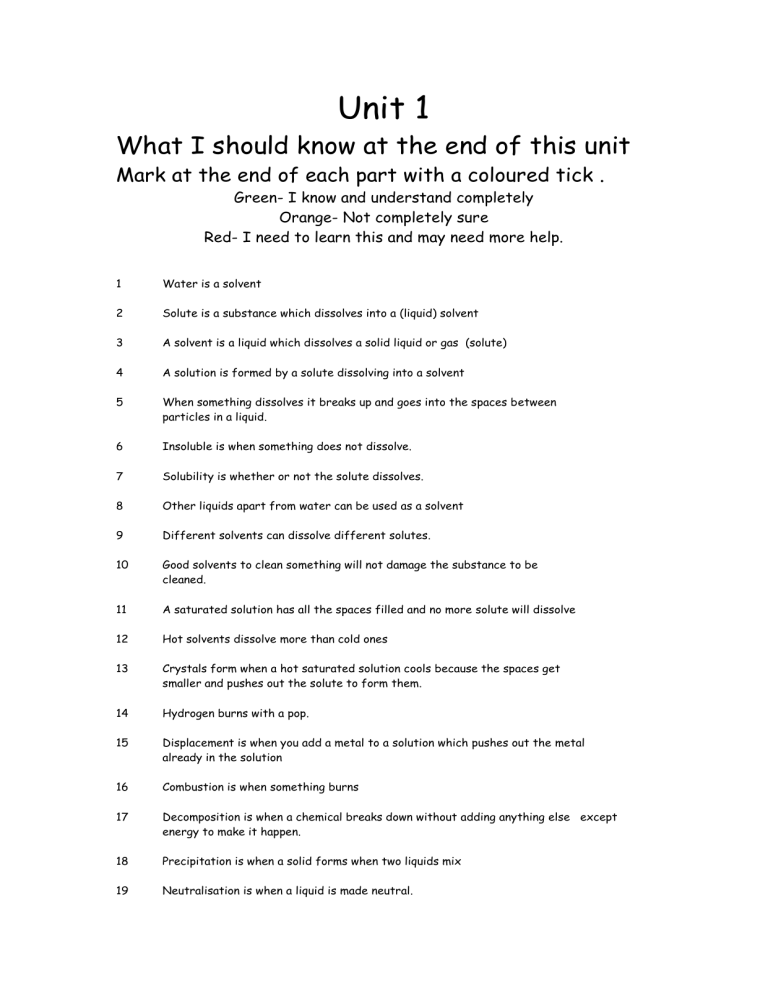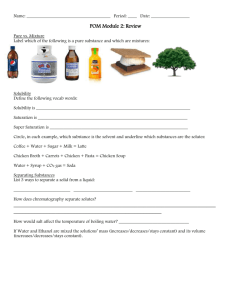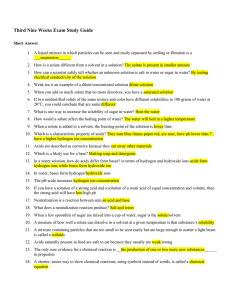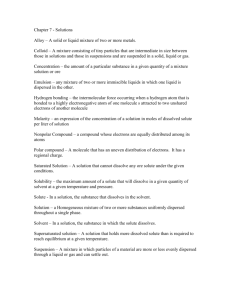Unit 1 Checklist - Kilmarnock Academy

Unit 1
16
17
13
14
15
18
19
8
9
10
6
7
11
12
4
5
1
2
3
What I should know at the end of this unit
Mark at the end of each part with a coloured tick .
Green- I know and understand completely
Orange- Not completely sure
Red- I need to learn this and may need more help.
Water is a solvent
Solute is a substance which dissolves into a (liquid) solvent
A solvent is a liquid which dissolves a solid liquid or gas (solute)
A solution is formed by a solute dissolving into a solvent
When something dissolves it breaks up and goes into the spaces between particles in a liquid.
Insoluble is when something does not dissolve.
Solubility is whether or not the solute dissolves.
Other liquids apart from water can be used as a solvent
Different solvents can dissolve different solutes.
Good solvents to clean something will not damage the substance to be cleaned.
A saturated solution has all the spaces filled and no more solute will dissolve
Hot solvents dissolve more than cold ones
Crystals form when a hot saturated solution cools because the spaces get smaller and pushes out the solute to form them.
Hydrogen burns with a pop.
Displacement is when you add a metal to a solution which pushes out the metal already in the solution
Combustion is when something burns
Decomposition is when a chemical breaks down without adding anything else except energy to make it happen.
Precipitation is when a solid forms when two liquids mix
Neutralisation is when a liquid is made neutral.
35
36
37
33
34
38
39
40
41
28
29
30
31
32
26
27
23
24
25
20
21
22
An element is different from a compound
When a reaction happens a new substance is made
A compound is made from elements joining together
Oxide is the name of a compound when an element reacts with oxygen
We can tell a reaction happens because a new substance always forms and we
Can sometimes see an energy change.
Other indicators of reaction are gas given off solid forms in liquid heats up or cools down or light given off
Some compounds can be broken up using electricity or heat.
Lime can be used to get rid of acidity in the soil
Lime dissolved in water makes lime water and this can be used to test for carbon dioxide
The periodic table is a list of all the known elements
A period is horizontal and a group is vertical.
I know at least 20 elements and their symbols and some uses..
Alkali metals are stored under oil to stop them reacting with oxygen and water
I know where metals/alkali metals /noble gases/transition metals and halogens are.
Alkali metals group (1 metals) react with water to give alkali's and hydrogen gas
Group 2 metals react slower than group 1 metals
Hydrogen is lighter than air.
Solubility of a compound can help identify where the metal in it comes from.
Chlorine (found in group 7) is a toxic green gas used as a disinfectant .
Chlorine reacts with copper to make copper chloride
Iodine sublimes from solid to gas with a little bit of heat.
Metals conduct heat and electricity and are malleable shiny and sonorous






